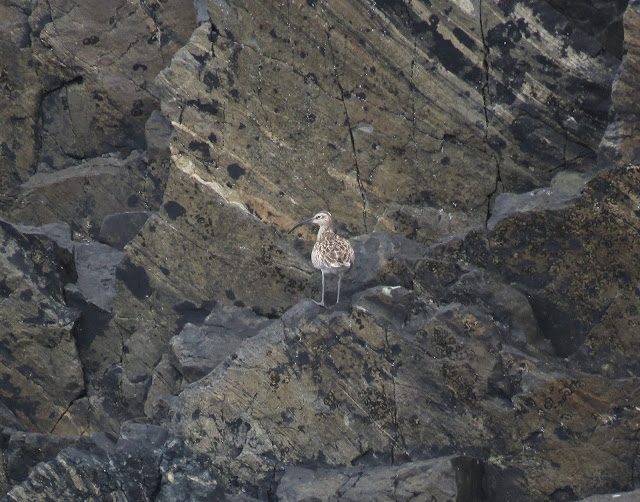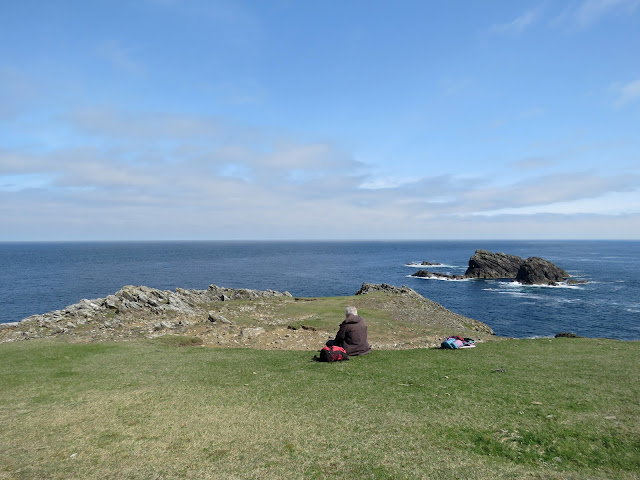Sunday, May 14, 2023
The A857 heading north across Lewis from Stornoway is a fast, straight road that takes no prisoners. Once you're on it you have to keep going - thanks to an absence of lay-bys - until you reach the west coast. There, in Barvas, we saw a sign to a memorial cairn and gratefully turned down a quiet lane to a lovely loch set in the machair, where we could at last park and eat our rather luxurious smoked salmon sandwiches with Philadelphia soft cheese, prepared that morning by Greger before we caught the ferry.
We hadn't heard of Loch Mor Bharabhais, so this place was a nice surprise. Greger pointed out a white-tailed sea eagle flying over. A large flock of dunlin zoomed around the sandy shores, and terns rested and preened on a rocky spit. Scanning what appeared to be a mix of common and Arctic terns, I was thrilled to see a little tern as well.
We walked out to the dunes and looked over the sea, and then it was back to the car and on to the Butt of Lewis. On the map it looks unpromising, with houses along the road to within a kilometre and a half of this northernmost point of the island; but at last you go up a single-track road with open moorland each side until you reach the lighthouse; and then it feels wild enough, with savage rock scenery and cliff-tops that stretch away into the distance, short-turfed and great for walking. I snapped fulmars nesting in the thrift, while Greger zoomed in on one pair.
It was fairly cool, with the Butt living up to its name as one of the windiest places in the UK; we hoped we'd have better weather the following day and drove back to our digs at the Cross Inn.
In fact, Friday dawned fair and sunny and we got up to the Butt early as the parking is limited. A whimbrel flew over the sea towards us and then landed on one of the off-shore rocks.
Making our way round the lighthouse and heading up the slope beyond, we saw a second whimbrel on the skyline.
On a small headland, the spongy turf ended abruptly with a step down to rockier ground - this edge providing an excellent seat for watching the sea.
My target bird was pomarine skua. I've been meaning for about three years to get to some headland in May, hoping to see these birds which, in spring, should have their "spoons" - thus enabling me to identify them with some confidence. The Butt of Lewis, I thought, might be just the spot - trouble was, no-one had informed the poms!
However, it was a beautiful place to while away a morning - especially with such lovely weather. We'd had a good cooked breakfast but after three hours we felt like coffee and cake, and started to pack up our things for the walk back to the car. I looked out over the sea one more time - and froze. Three or four "torpedoes" were moving swiftly through the water towards us, and I gabbled out "What's this?!" We got bins to our eyes and realised - they were orca! Greger had his posh camera with him and took the first two photos; the third one is mine, and possibly of interest because of the apparent marks (rake marks?) on the animal's body.
These were our first-ever killer whales, and we were understandably excited. I thought there were at least four individuals, but the top picture seems to show five. We had been alone for most of the morning, but now we heard voices - and there behind us were three or four people with tripods, who had apparently had good views of the orca below the lighthouse, and then come round to our side as they moved south along the coast. After about eight minutes according to the times on my pictures, the orca were gone.
After coffee and cake we went back and did another stint, but had no further luck with either birds or cetaceans.
It was hard to leave this wonderful place, but we needed to get back to Stornoway for our second night's lodging. On the way Greger suggested visiting the RSPB reserve of Loch na Muilne - the breeding place of red-necked phalaropes. We learned from the information board that the birds return in late May, so we were probably a bit early. A little grebe, a pair of teal, and a greenshank were seen - but best of all, I realised that the pink vegetation that attracts the phalaropes (for the insect life it holds) was actually one of my favourite wildflowers - bogbean. We were glad to have seen these little lochs set in the windswept (and currently dry) moorland even without the phalaropes.
The hill-top commands an extensive view of the sea, and the benches in the shelter were excellent for sitting down to have our inevitable coffee and cake.
It was colder today and fairly windy, and no-one else ventured up the hill; so when we descended to the road we were surprised to find there were now quite a few people around. A cluster of seabirds in a sort of feeding frenzy seemed interesting, but a rather fatalistic man with a dog and a pair of bins told Greger that it had been there in the same place for days, and sometimes if you watched it long enough you might see a minke whale, and sometimes you might not. In any case we had to leave to catch the ferry; so we weren't going to see any whales or (my particular wish) Risso's dolphins.
I'm sure she was right though because you don't come out with names like "Atlantic white-sided dolphin" unless you know what you're talking about. There must have been a couple of pods and I followed the wrong one. Typical.













.jpeg)

.jpeg)

